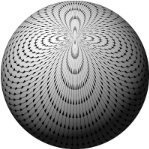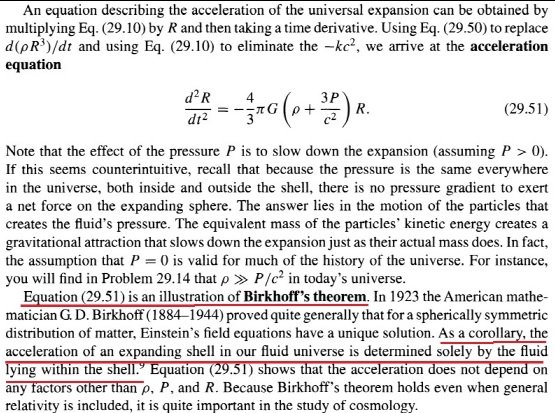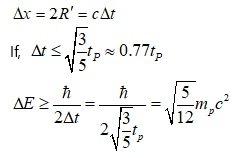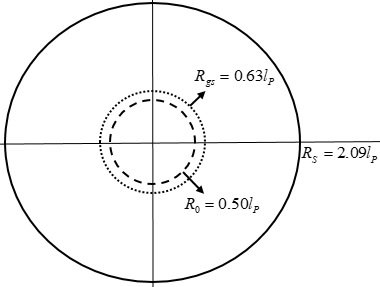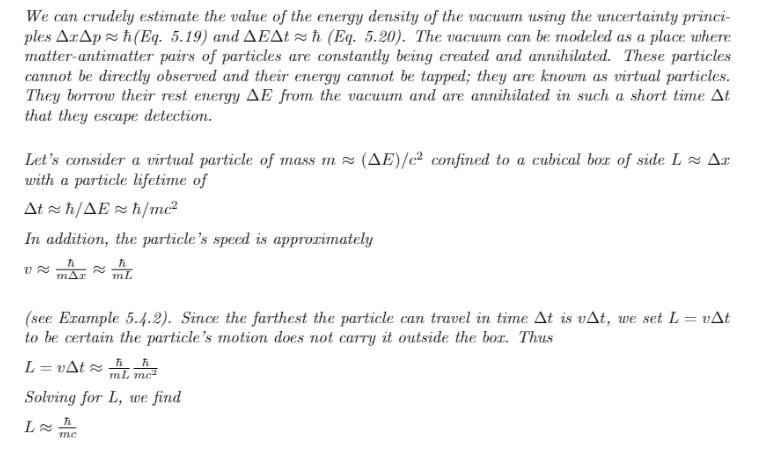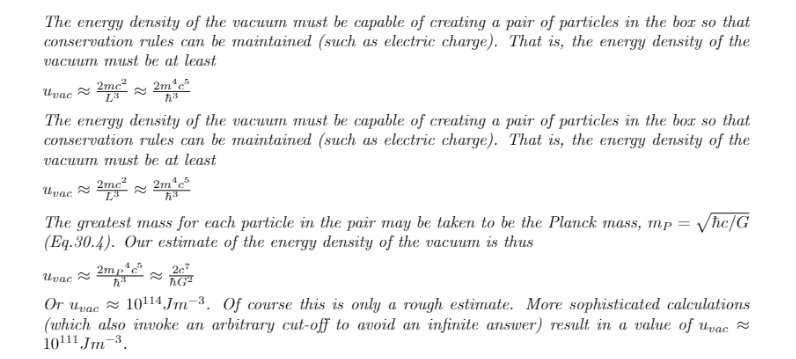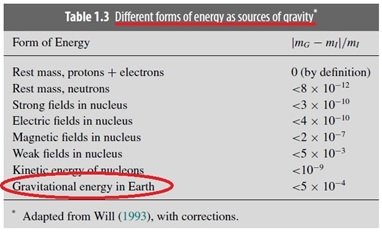-
Posts
107 -
Joined
-
Last visited
icarus2's Achievements

Baryon (4/13)
16
Reputation
-
If the universe was nothing at the beginning, how did this state of nothing then create what is the universe? We don't yet know what the answer is. However, because it is an important issue, I am writing my personal opinion. Let's start with the following equation: A = A Before the universe was birthed, the concept of A did not even exist. This A is an concept created by intellectual creature called humanity, 13.8 billion years after the creation of the universe. Also, mathematical terms, including =, are concepts created by humans born after the birth of the universe. If we move "A" from the left side to the right side, 0 = A - A = 0 To make the idea clearer, let's express this a little differently. 0 = (+A) + (-A) = 0 This equation can be conceptually decomposed as "0", "0=(+A)+(-A)", "(+A)+(-A)=0", "0=0". 1)"0" : Something did not exist. Nothing state. 2)"0 = (+A) + (-A)" : (+A) and (-A) were born from "nothing". Or "nothing" has changed to +A and -A. Something state. 3)"(+A) + (-A) = 0" : The sum of (+A) and (-A) is still zero. From one perspective it's "something state", from another perspective it's still “nothing state”. 4)"0 = 0" At the beginning and end of the process, the state of “nothing” is maintained. 5) "B = 0 = (+A) + (-A) = 0" : The intelligent life form called humanity defines the "first nothing" as B. B may be total A, which is the sum of all A, or it may be a new notion. In other words, “nothing” can create something +A and something -A and still remain “nothing” state. And, the newly created +A and -A create new physical quantities and new changes. For example, in order for the newly created +A and -A to be preserved in space, a new relational equation such as a continuity equation must be created. ∂ρ/∂t + ∇·j=0 Let's look at how pair production occurs from photon (light). B = 0 = (+Q) + (-Q) = 0 The charge of a photon is zero. When photon do pair production, photon do not conserve charge by creating beings with zero charge, but by creating +Q and -Q to preserve zero. That is, in all cases, in all circumstances, in order to satisfy or maintain “nothing”, this equation of the form (+Q) + (-Q) = 0 must hold. This may be because "0" is not representative of all situations and is only a subset of (+Q) + (-Q) = 0. At the beginning and end of the process, the total charge is conserved, but in the middle process +Q and -Q are created. Due to the electric charge generated at this time, new concepts including electromagnetic fields and electromagnetic forces are needed. According to Emmy Noether's theorem, if a system has a certain symmetry, there is a corresponding conserved physical quantity. Therefore, symmetry and conservation laws are closely related. Conservation of spin, conservation of particle number, conservation of energy, conservation of momentum, conservation of angular momentum, conservation of flux... etc.. New concepts may be born from conservation laws like these. Let’s look at the birth process of energy. https://icarus2.quora.com/The-Birth-Mechanism-of-the-Universe-from-Nothing-and-New-Inflation-Mechanism E_T = 0 = (+E) + (-E) = Σmc^2 + Σ(-Gmm/r) = 0 “E_T = 0” represents “Nothing” state. Mass appears in “Σ(+mc^2)” stage, which suggests the state of “Something”. In other words, “Nothing” produces a negative energy of the same size as that of a positive mass energy and can produce “Something” while keeping the state of “Nothing” in the entire process (“E_T = 0” is kept both in the beginning of and in the end of the process). Another example is the case of gauge transformation for scalar potential Φ and vector potential A in electromagnetic fields. Φ --> Φ - ∂Λ/∂t A --> A + ∇Λ Maxwell equations of electromagnetism hold them in the same form for gauge transformation. After all, the existence of some symmetry or the invariance that the shape of a certain physical law must not change requires a gauge transformation, and this leads to the existence of new physical quantities (Λ, ∂Λ/∂t, ∇Λ) that did not exist in the beginning (Φ, A). This can be interpreted as requiring the birth of a new thing in order for the conserved physical quantity to be conserved and not change. The condition or state that should not change is what makes change. Why was the universe born? Why is there something rather than nothing? Why did the change happen? B = 0 = (+Q) + (-Q) = 0 E_T = 0 =(+E) + (-E) = Σmc^2 + Σ-Gmm/r = 0 ∂ρ/∂t + ∇·j=0 Φ --> Φ - ∂Λ/∂t A --> A + ∇Λ It changes, but does not change! It changes in order not to change! What does not change (B = 0) also creates changes in order not to change in various situations (Local, Global, phase transformation, translation, time translation, rotation transformation ...). This is because only the self (B) that does not want to change needs to be preserved. The change of the universe seems to have created a change by the nature of not changing. The universe created Something (space-time, quantum fluctuation, energy, mass, charge, spin, force, field, potential, conservation laws, continuity equation...) to preserve Nothing. By the way, as this something was born, another something was born, and the birth of something chained like this may still preserve the first "nothing", and in some cases, the first "nothing" itself may also have changed.
-
Mathematics began as human intellectual activity to describe phenomena that exist in nature and the universe. Therefore, mathematics and the universe have a very deep connection, and events that occur in the universe can generally be described through mathematics. However, in mathematics, if a proposition is true within a defined axiomatic system, then this proposition is true and has value. In other words, because mathematics reflects human intellectual activity, even things that are imaginary can become true. On the other hand, the universe is true to exist and has value. Therefore, mathematics and the universe are not completely the same thing.
-
Pressure, energy, and mass are all sources of gravity. Therefore, these terms enter the Friedmann equation and play the role of -(4πG/3)p, which is the gravitational effect. According to Birkhoff’s theorem, The first Friedmann equation without a cosmological constant is derived from general relativity, but there is also a form derived from the conservation of mechanical energy of Newtonian mechanics (dust model), and this is taught in major books. At this time, the terms entered are kinetic energy and gravitational potential energy. [math]\frac{1}{2}m{v^2}(t) - G\frac{{{M_r}m}}{{r(t)}} = E[/math] Therefore, the right-hand side term (8πG/3)ρ comes from the total mass M_r inside the shell. Friedmann's second equation without a cosmological constant is also derived from general relativity, but can also be derived from F=ma=-GMm/R^2. This also uses gravitational force. Because this is intuitive, if we look at this derivation process [math]ma = - \frac{{GMm}}{{{R^2}}}[/math] [math]m\frac{{{d^2}R(t)}}{{d{t^2}}} = - \frac{{GM(t)m}}{{R{{(t)}^2}}}[/math] [math]M(t) = \frac{{4\pi {R^3}(t)}}{3}\rho (t) = \frac{{4\pi {a^3}(t){R^3}}}{3}\rho (t)[/math] [math]m\frac{{{d^2}a(t)R}}{{d{t^2}}} = - Gm\frac{{\frac{{4\pi }}{3}{a^3}(t){R^3}\rho (t)}}{{{a^2}(t){R^2}}} = - Gm\frac{{4\pi }}{3}a(t)R\rho (t)[/math] [math]\frac{{\ddot a(t)}}{{a(t)}} = - \frac{{4\pi G}}{3}\rho (t)[/math] Adding pressure, we can create an acceleration equation. [math]\frac{{\ddot a}}{a} = - \frac{{4\pi G}}{3}(\rho + \frac{{3P}}{{{c^2}}})[/math] In other words, we can see that ρ(t) is the mass density inside the expanding shell, and the -(4πG/3)ρ term describes gravity or gravitational effects. It can be seen that the total mass M inside the shell is included in both Friedmann equations 1 and 2. This means that the equivalent mass of total energy is included. If matter and radiation have the same energy density ρ0, it is thought that they should be the same when entering the acceleration equation. In my opinion, We can put in the equivalent mass of the energy density of the radiation divided by c^2, and let the pressure of the radiation be 0, or since the rest mass of the radiation is 0, let the mass density be 0, and in the pressure term (1/3)ρ must be inserted. Photons are also included as relativistic particles. However, in this explanation, I tried to distinguish between relativistic particles that have rest mass and photons that do not have rest mass. For photons, which do you think is correct: 1ρ0 or 2ρ0 ?
-
Consider a situation where matter and radiation have the same energy density ρ_0. If we set c=1, mass density = energy density For matter, [math]{\rho _m} + 3P{}_m = {\rho _m} + 3(0) = {\rho _m} = {\rho _0}[/math] For radiation (photon), [math]{\rho _r} + 3P{}_r = {\rho _r} + 3(\frac{1}{3}{\rho _r}) = 2{\rho _r} = 2{\rho _0}[/math] Now if we think about the physical meaning of the two cases, This means that if matter and radiation have the same energy density ρ_0, the gravitational effect of the radiation is twice that of the matter. If photon and matter have the same energy density, does the photon exert twice the gravitational force (or effect) than the material exerts? Is this true? In my opinion, In the case of photon, it seems wrong to include both density in the (mass) density term and pressure term.
-
I think I didn't phrase the question appropriately. [math]\frac{1}{R}(\frac{{{d^2}R}}{{d{t^2}}}) = - \frac{{4\pi G}}{3}({\rho _m} + {\rho _r} + {\rho _\Lambda } + \frac{{3({P_m} + {P_r} + {P_\Lambda })}}{{{c^2}}})[/math] [math]\rho + \frac{{3P}}{{{c^2}}} = ({\rho _m} + \frac{{3P{}_m}}{{{c^2}}}) + ({\rho _r} + \frac{{3P{}_r}}{{{c^2}}}) + ({\rho _\Lambda } + \frac{{3P{}_\Lambda }}{{{c^2}}})[/math] In this question the first and third terms are not of interest. What happens if you summarize(Energy density of photon ρ) the second term? When the energy density of a photon is ρ, I am curious as to whether its gravitational effect in the acceleration equation is 1ρ or 2ρ. *When considering the dimension, it must be divided by c^2, but this is not an important issue. [math]{\rho _r} + \frac{{3P{}_r}}{{{c^2}}} = [/math]
-
Gravitational effect and pressure of photons in Friedmann equation? [math] \frac{1}{R}(\frac{{{d^2}R}}{{d{t^2}}}) = - \frac{{4\pi G}}{3}({\rho _m} + {\rho _r} + {\rho _\Lambda } + \frac{{3({P_m} + {P_r} + {P_\Lambda })}}{{{c^2}}}) [/math] ρ is the unit of mass density. Pressure of matter : P=0 Pressure of radiation : P=(1/3)ρc^2 Regarding the source of pressure, there are the following expressions in major books: In special relativity, [math]{E^2} = {({m_0}{c^2})^2} + {(pc)^2}[/math] For matter, [math]{E^2} = {({m_0}{c^2})^2}[/math] For, relativistic particle, [math]{E^2} = {({m_0}{c^2})^2} + {(pc)^2}[/math] For, radiation or photon, [math]{E^2} = {(pc)^2}[/math] So, here's the question. For a relativistic particle with rest mass it would be: [math]{E^2} = {({m_0}{c^2})^2} + {(pc)^2}[/math] In the case of relativistic particles, there is a pressure component due to kinetic energy or momentum, and this value cannot be ignored compared to mass energy. [math]\frac{1}{R}(\frac{{{d^2}R}}{{d{t^2}}}) = - \frac{{4\pi G}}{3}({\rho _{{\rm{relativistic particle}}}} + \frac{{3{P_{{\rm{relativistic particle}}}}}}{{{c^2}}}) = - \frac{{4\pi G}}{3}({\rho _{{\rm{rel - par}}}} + \frac{{3(\frac{1}{3}{\rho _{{\rm{rel - par}}}}{c^2})}}{{{c^2}}}) = - \frac{{4\pi G}}{3}(2{\rho _{{\rm{rel - par}}}})[/math] [math]\frac{1}{R}(\frac{{{d^2}R}}{{d{t^2}}}) = - \frac{{4\pi G}}{3}(2{\rho _{{\rm{rel - par}}}}) = - \frac{{4\pi G}}{3}(\frac{{2{\rho _{{\rm{rel - par}}}}{c^2}}}{{{c^2}}})[/math] When the energy density of matter is ρ, in the Friedmann equation, matter generates the gravitational effect of ρ. When the energy density of a relativistic particle is ρ, in the Friedmann equation, the relativistic particle generates a gravitational effect of 2ρ. But what about photons, which are not relativistic particles? Which expression is correct for photons that have no rest mass? 1) [math]\frac{1}{R}(\frac{{{d^2}R}}{{d{t^2}}}) = - \frac{{4\pi G}}{3}({\rho _{rad}} + \frac{{3(\frac{1}{3}{\rho _{rad}}{c^2})}}{{{c^2}}}) = - \frac{{4\pi G}}{3}(2{\rho _{{\rm{rad}}}}) = - \frac{{4\pi G}}{3}(\frac{{2{\rho _{{\rm{rad}}}}{c^2}}}{{{c^2}}})[/math] Considering radiation(When limited to photons) with energy density ρ, it generates a gravitational effect equal to twice the energy density : 2ρ ? 2) [math]\frac{1}{R}(\frac{{{d^2}R}}{{d{t^2}}}) = - \frac{{4\pi G}}{3}({\rho _{{\rm{radiation}}}} + \frac{{3{P_{{\rm{radition}}}}}}{{{c^2}}}) = - \frac{{4\pi G}}{3}(0 + \frac{{3(\frac{1}{3}{\rho _{rad}}{c^2})}}{{{c^2}}}) = - \frac{{4\pi G}}{3}({\rho _{{\rm{rad}}}}) = - \frac{{4\pi G}}{3}(\frac{{{\rho _{{\rm{rad}}}}{c^2}}}{{{c^2}}})[/math] Considering radiation(When limited to photons) with energy density ρ, it generates a gravitational effect equal to 1 times the energy density : 1ρ ? 1) Is the expression correct? 2) Is the expression correct?
-
In the post just above, Even if there was no energy before the Big Bang, enormous amounts of energy can be created due to the uncertainty principle. In a region smaller than the size of an atomic nucleus, the total mass-energy that exists in the observable universe can be created. In the early universe, when only positive mass energy is considered, the mass energy value appears to be a very large positive energy, but when negative gravitational potential energy is also considered, the total energy can be zero and even negative energy. Considering not only mass energy but also gravitational potential energy, the total energy of the system is According to the uncertainty principle, during Planck time, energy fluctuations of more than (1/2)m_pc^2 are possible. However, let us consider that an energy of ΔE=(5/6)m_pc^2, slightly larger than the minimum value, was born. 1) If, Δt=t_p, ΔE=(5/6)m_pc^2, The total energy of the system is 0. In other words, a mechanism that generates enormous mass (or energy) while maintaining a Zero Energy State is possible. 2) If, Δt=(3/5)^(1/2)t_p, ΔE≥(5/12)^(1/2)m_pc^2, The total energy of the system is 0. In other words, a mechanism that generates enormous mass (or energy) while maintaining a Zero Energy State is possible. This is not to say that the total energy of the observable universe is zero. This suggests that enormous mass energy can be created from a zero energy state in the early stages of the universe. In this way (If we are limited to what is explained in this post~), the total energy of one quantum fluctuation is zero energy. Since individual quantum fluctuations are born in a zero energy state, and as time passes, the range of gravitational interaction expands, when surrounding quantum fluctuations come within the range of gravitational interaction, accelerated expansion occurs by this method. This method uses the minimum value of energy fluctuations. On the other hand, at energies greater than the minimum, expansion can occur even from a single quantum fluctuation. Through this model, we can simultaneously solve the problem of the origin of enormous energy and the problem of accelerated expansion in the early stages of the universe.
-
A combined model of the uncertainty principle and gravitational potential energy provides an explanation for how the universe was born and expanded in a dense state. [math] \Delta E\Delta t \ge \frac{\hbar }{2}[/math] From the energy-time uncertainty principle, If, [math]\Delta t \approx {t_P} = 5.391 \times {10^{ - 44}}s[/math] [math]\Delta E \ge \frac{\hbar }{{2\Delta t}} = \frac{\hbar }{{2{t_P}}} = \frac{1}{2}m{}_P{c^2}[/math] Δx=ct_p=2R’ : Since Δx corresponds to the diameter of the mass distribution Assuming a spherical mass distribution and calculating the average mass density (minimum value), [math]\frac{1}{2}{m_P} = \frac{{4\pi {{R'}^3}}}{3}{\rho _0} = \frac{{4\pi {{(\frac{{c{t_P}}}{2})}^3}}}{3}{\rho _0}[/math] [math]{\rho _0} = \frac{3}{\pi }\frac{{{m_P}}}{{{l_P}^3}} = \frac{3}{\pi }{\rho _P} \simeq 4.924 \times {10^{96}}kg{m^{ - 3}}[/math] It can be seen that it is extremely dense. In other words, the quantum fluctuation that occurred during the Planck time create energy with an extremely high density. The total mass of the observable universe is approximately 3.03x10^54 kg (used to ρ_c=8.5x10^-27 kg/m^3), and the size of the region in which this mass is distributed with the initial density ρ_0 is R_obs-universe (ρ=ρ_0) = 5.28x10^-15 [m] This value is approximately the size of an atomic nucleus. Not all models can account for the high dense state of the early universe. Also, not all models can provide repulsion or expansion to overcome the very strong gravity in this high-density state. So it's a decent result. [ Verifiability ] As a key logic to the argument of this paper, gravitational potential energy appears, and the point where the magnitude of the negative gravitational potential energy equals the positive mass energy becomes an inflection point, suggesting that the accelerated expansion period is entered. [math]{R_{gs}} = \sqrt {\frac{{5{c^2}}}{{4\pi G{\rho _0}}}} [/math] Since we can let R_gs be approximately ct(for a space with uniform energy (mass) density) or cΔt/2(with the uncertainty principle applied, if the energy (mass) distribution enters an accelerated expansion within Δt), there is a strong constraint equation between the density and the time the universe entered accelerated expansion. Therefore, it is possible to verify the model through this. It is necessary to create an early universe accelerating expansion model to which the ideas in this paper are applied. When such precise models come out, there will be more factors that can verify the model's accuracy.
-
*Revision Mass energy is of the form \(E=Mc^{2}\) and remains constant. On the other hand, the gravitational potential energy is of the form \({U_{gs}} = - \frac{3}{5}\frac{{G{M^2}}}{R}\), and the absolute value decreases as R increases. Therefore, when the mass distribution expands, only the absolute value of the negative gravitational potential energy term decreases, so the system switches to the positive mass state after \(R=R_{gs}\). The reduced gravitational potential energy will be converted into kinetic energy. For example, if the mass in the system is constant and R (R is the radius of the mass distribution) doubles from \(R_0\) to \(2R_0\), it can be seen that the absolute value of the gravitational self-energy is reduced by a factor of \(\frac{1}{2}\).
-
3.6. The Vacuum Catastrophe Problem or Cosmological Constant Problem The vacuum catastrophe problem or the cosmological constant problem is a problem in which there is a large difference between the theoretical prediction of vacuum energy proposed by quantum field theory and the observed value. It is known that there is a difference of about 10^120 between theoretical predictions and observed values. Strictly speaking, the vacuum energy model is only one of the dark energy models, so the observed (or estimated from observed results) dark energy density may not be the density of vacuum energy. Therefore, the actual vacuum energy density can be the dark energy density, or zero, or negative. However, if the density of vacuum energy is greater than the dark energy density, it will have a larger effect than the dark energy term, so it can be excluded by observational results. Therefore, the upper limit of the observed vacuum energy density is approximately the dark energy density, and there is still a difference of more than 10^120 times between the theoretical prediction value and the actual vacuum energy density value. First, looking at the claims of the vacuum energy model, Since there is energy ΔE or u_{vac}, which is one of the sources of gravity, and there is time Δt for gravity to propagate, the gravitational self-energy must also be considered in this problem. So, to look at the mainstream estimates in terms of my model, let's do some calculations. We have an equation for calculating the total gravitational potential energy in the case of a spherical, uniform distribution. This value is called the gravitational self-energy. In the vacuum energy model, calculations were performed as a regular hexahedron with one side L. If we consider a spherical space inside a regular hexahedron, the value of the vacuum energy density will be the same in this case. Since there is an expression for gravitational self-energy already calculated for spherical space, to utilize it, let's consider a spherical energy (mass) distribution with \(R = \frac{L}{2}\). According to the mass-energy equivalence principle, it is possible to define the equivalent mass (m = E/c^2) for all energies. Therefore, in this paper, the terms equivalent mass energy or mass energy or mass are sometimes used for objects with positive energy. 3.6.1. Vacuum energy in space R = L/2 [math]{E_{vac}} = \frac{{4\pi {R^3}}}{3}{u_{vac}} = \frac{{4\pi {{(\frac{L}{2})}^3}}}{3}(\frac{{2{c^7}}}{{\hbar {G^2}}}) = \frac{{4\pi {{(\frac{\hbar }{{2{m_P}c}})}^3}}}{3}(\frac{{2{c^7}}}{{\hbar {G^2}}}) = \frac{\pi }{3}{m_P}{c^2}[/math] [math]{E_{vac}} = \frac{\pi }{3}{m_P}{c^2} \simeq + 1.047{m_P}{c^2}[/math] 3.6.2. The gravitational potential energy of the vacuum energy of space R = L/2 [math]{U_{gs}} = - \frac{3}{5}\frac{{G{M^2}}}{R} = - \frac{3}{5}\frac{{G{{(\frac{\pi }{3}{m_P})}^2}}}{{\frac{L}{2}}} = - \frac{3}{5}\frac{{G{{(\frac{\pi }{3}{m_P})}^2}}}{{(\frac{\hbar }{{{2m_P}c}})}} = - \frac{{2{\pi ^2}}}{{15}}{m_P}{c^2}[/math] [math]{U_{gs}} = - \frac{{2{\pi ^2}}}{{15}}{m_P}{c^2} \simeq - 1.316{m_P}{c^2}[/math] 3.6.3. The event horizon created by vacuum energy \({E_{vac}} = \frac{\pi }{3}{m_P}{c^2}\) [math]{R_S} = \frac{{2GM}}{{{c^2}}} = \frac{{2G(\frac{\pi }{3}{m_P})}}{{{c^2}}} = \frac{{2\pi }}{3}{l_P} \simeq 2.094{l_P}[/math] 3.6.4. The radius R_gs at which the magnitudes of positive mass energy and negative gravitational potential energy are equal [math]|\frac{{{U_{gs}}}}{{{E_{vac}}}}| = |\frac{{ - \frac{3}{5}\frac{{G{{(\frac{\pi }{3}{m_P})}^2}}}{R}}}{{\frac{\pi }{3}{m_P}{c^2}}}| = | \frac{{\frac{\pi }{5}\frac{{G{m_P}}}{{{c^2}}}}}{R}| = 1 [/math] [math] {R_{gs}} = \frac{\pi }{5}{l_P} = 0.628{l_P} [/math] 3.6.5. Physical meaning of calculated R values [math] {E_T}(t = \Delta t) = {E_{vac}} + {U_{gs}} = \frac{\pi }{3}{m_P}{c^2} - \frac{{2{\pi ^2}}}{{15}}{m_P}{c^2} \simeq - 0.269{m_P}{c^2} < 0 [/math] Initially, since the negative gravitational potential energy is greater than the positive mass energy, the mass distribution at \({R_0} = \frac{L}{2}\) will expand. If there is no additional mass influx (or if mass is held constant), when the expanding mass distribution passes \(R_{gs}\), the negative gravitational potential energy equals the positive mass energy. When the mass distribution becomes larger than R_gs, since the positive mass energy is greater than the negative gravitational potential energy, the system switches to the positive mass state, and thus the situation in which the attractive force acts. Thus, the mass distribution will contract back to R_gs. Mass energy is of the form E=Mc^2 and remains constant. On the other hand, the gravitational potential energy is of the form \({U_{gs}} = - \frac{3}{5}\frac{{G{M^2}}}{R}\), which decreases as R increases. Therefore, when the mass distribution expands, only the negative gravitational potential energy term decreases, so the system switches to the positive mass state after R=R_gs. The reduced gravitational potential energy will be converted into kinetic energy. For example, if the mass in the system is constant and R (R is the radius of the mass distribution) doubles from R_0 to 2R_0, it can be seen that the gravitational self-energy is reduced by a factor of 1/2. [math] {U_{gs}}(R = {R_0}) = - \frac{3}{5}\frac{{G{M^2}}}{{{R_0}}} [/math] [math] {U_{gs}}(R = 2{R_0}) = - \frac{3}{5}\frac{{G{M^2}}}{{2{R_0}}} = \frac{1}{2}{U_{gs}}(R = {R_0}) [/math] R < R_gs : system is in negative energy (mass) state. Since the repulsive force component is greater than the attractive force component, the mass distribution expands. R > R_gs : The system is in a positive energy (mass) state. Since the attractive force component is greater than the repulsive force component, the mass distribution undergoes deceleration expansion and contraction. Therefore, the mass distribution becomes stable at R=R_gs while oscillating around R=R_gs. The point where R=R_gs is the point where the total energy of the system is zero. One of the important characteristics is that it vibrates (repeating acceleration and deceleration expansion) based on R=R_gs, and finally stabilizes at R=R_gs. This is because the R=R_gs point is the point where the positive and negative energy components are equal, and the total energy of the system is zero. Although we are analyzing the process in detail, the time interval between these events is approximately t_P ~ 10^{-44}s. As a rough estimate, if there is no additional mass density generation within the 1l_P(Planck length, approximately 2(0.50(l_P))) range, the mass distribution will converge to R_gs where the positive mass energy equals the negative gravitational potential energy. As a result, the mass distribution returns to the zero-energy state because the magnitudes of the positive mass energy and the negative gravitational self-energy in R_gs are equal. Also, since the event horizon R_S=2.09(l_P) formed by the mass distribution of R_0 is greater than R_gs=0.63(l_P), the mass distribution exists inside the event horizon. Therefore, the mass distribution does not escape the event horizon, converges to R_gs, and finally returns to nothing. And, as a problem of consideration, when a stellar black hole forms, the space-time outside the black hole is affected and curved during the process of forming the black hole. By the way, after forming the black hole, if the location of the mass distribution changes inside the black hole, does this also affect the space-time outside the black hole? It is estimated that gravity due to changes in the distribution of mass inside the black hole will not be able to escape the black hole. Even when gravity due to changes in the mass distribution inside the black hole affects the geometry of space-time outside the black hole, the effect is zero or very close to zero because of the gravitational properties of negative gravitational potential energy and positive mass energy described above. As in previous theoretical calculations, if the vacuum had an enormous energy of \({u_{vac}} \approx {10^{111}} \sim {10^{114}}J{m^{ - 3}}\), it should be observable around us. However, we are not detecting the presence of these enormous energies from the vacuum. Even if quantum fluctuations occur in vacuum according to existing theoretical assumptions, since ΔE and Δt exist, their own gravitational interactions must also be taken into account. Therefore, considering the gravitational self-energy, the vacuum energy density is likely to be zero, unless the frequency of quantum fluctuations in the vacuum is extremely high. If the frequency of occurrence of quantum fluctuations is less than approximately 1 within the range of radius l_P during the 5t_P(rough estimate), it can be estimated that the total energy of the quantum fluctuations produced will be in the zero energy. For example, as a rough estimate, let's assume that 1 quantum fluctuation occurs within a radius of 1(l_P, Planck length ) in 100(t_P) time. Even in this case, it suggests a return to the zero energy state by the above mechanism.This is the case assuming an enormous number of quantum fluctuations. This situation corresponds to the assumption of approximately 10^147 ( 100{t_P} ~10^{-42}s, 2(1{l_P}) ~ 10^{-35}m, Volume ~ 10^{-105}m^3) quantum fluctuations per second, in a space of 1m^3. Thus, vacuum energy is not a source of dark energy. If the problem is a simple situation that cannot explain the difference in density of 10^120, the possibility remains that the difference in density can be explained by some mechanism at some point in the future. The real problem with vacuum energy model is, First, that positive energy density (positive inertial mass density) and negative pressure are logically contradictory because the source of pressure is momentum or kinetic energy. Second, even in the case of light with the greatest momentum or kinetic energy component relative to the total energy, the pressure is \(P = \frac{1}{3}\rho \). The claims of the vacuum energy model require a being with a momentum or kinetic energy three times (\({P_\Lambda } = - {\rho _\Lambda } = - 3(\frac{1}{3}{\rho _\Lambda })\)) greater than that of light. Third, it is a problem related to the logic of \({\rho _\Lambda } + 3{P_\Lambda } = {\rho _\Lambda } + 3( - {\rho _\Lambda }) = - 2{\rho _\Lambda }\). Mass density ρ and pressure P are properties that an object has. Also, mass density ρ and pressure P are the sources of gravity. However, even if the volume does not expand or contract and maintains a constant size, it means that the gravitational force of \({\rho _\Lambda } + 3{P_\Lambda } = - 2{\rho _\Lambda }\) is applied. That is, it suggests that the object (or energy density) has a gravitational force with a negative mass density of -2ρ_Λ. This is different from a vacuum, which we think has a positive energy density +ρ_Λ. Fourth, it also seems that there is a problem in applying dU = - PdV to vacuum energy. And, there are models that are 10^120 more accurate than the vacuum energy model. The Birth Mechanism of the Universe from Nothing and New Inflation Mechanism https://www.researchgate.net/publication/371951438
-
Inline math is displayed in the flow of a sentence \(m{c^2}\). hm [math] y = \int f(x) dx [/math] Inline brackets: \( y = x^2 \) Inline brackets: \[ y = x^2 \]
-
First of all, thank you for your sincere advice. Actually I lack knowledge and skills. My research is a personal hobby. It is true that I need to study more to make my hobby more meaningful. However, on the other hand, should I have to study hard to enjoy my hobby? Even if I study, there is still a high entry barrier, and I am not sure if I will overcome the entry barrier. As for my current interests, I have some interest in publishing my research on arXiv or mainstream journals. arXiv requires endorsements from other scientists. Even with the endorsement of another scientist, the administrator will delete it arbitrarily. I've had that process a few times, so, now I don't even try. I think this paper contains very cool ideas and is worthwhile. By any chance, do you have any intention of summarizing the content of my thesis in half and submitting it to a journal as a corresponding author? I can also solve the vacuum catastrophe problem! However, the result may not be what you expect. However, it is a solution that did not exist before, and it will be a pioneer of a new path. Vacuum catastrophe problem has not yet been added to this thesis. I will update this post with that in a week or less. Once again, thank you for your goodwill.
-
That part introduces beings with energy just to explain the characteristics of gravitational potential energy. The situation in which universe exists after birth from zero energy is the content of chapter 4.1 ~ 4.2. Of course, it is not completely nothing because it assumes the existence of principles of physics such as the uncertainty principle, but the term "nothing" is sometimes used in that it starts from zero energy.
-
The phrase I wrote is this. In Figure 1, if the mass-energy within the radius R_1 interacted gravitationally at t_1 (an arbitrary early time), the mass-energy within the radius R_2 will interact gravitationally at a later time t_2. As the universe ages, the mass-energy involved in gravitational interactions changes, resulting in changes in the energy composition of the universe. The total energy $E_{T}$ of the system is [math]{E_T} = \sum\limits_i {{m_i}{c^2}} + \sum\limits_{i < j} { - \frac{{G{m_i}{m_j}}}{{{r_{ij}}}}} = M{c^2} - \frac{3}{5}\frac{{G{M^2}}}{R}[/math] And, it is a matter of interpreting mass-energy as a being with mass or energy. It's just a summary of a 24-pages thesis. And, in the introduction of the thesis, there are the following passages: In addition, although there are electric charges, spins, and various physical quantities, it is necessary to analyze the problem of expanding the universe due to gravitational interactions because the object will be a being with at least energy (mass) even in various situations. I'm sorry for you too. I didn't understand what you meant. I misunderstood this sentence(As mentioned energy is the property describing the ability to perform work. It isn't something that exists on its own.) you wrote. I am so sorry. The total energy E_{T} of the system And, mass-energy means a being with mass or energy.
-
I think this claim( It isn't something that exists on its own.) about potential energy is false. Potential energy should be treated as real energy, not virtual energy. Potential energy must have a specific value under specific circumstances. 1. In the calculation of potential energy, not only the calculation through the amount of change is successful. Calculations with own values(I don't know what to choose as the right word. own value?) also succeed. In other words, even if the calculation through the change is successful, it does not guarantee that it is correct. U=mgh or U=-GMm/r 2. Looking at the electromagnetic potential energy similar to the gravitational potential energy, + + or - - : When the same kind of charge exists, [math]{U_{ + + }} = + \frac{{k{q_1}{q_2}}}{r} + {c_1}[/math] + - : When charges of different species exist, [math]{U_{ + - }} = - \frac{{k{q_1}{q_2}}}{r} + {c_2}[/math] 1)The situation where +Q+Q and +Q-Q exist seems to be a symmetrical situation, should c1, c2 exist? 2)Let's assume that the constants are the same as c1=c2, + + : When same kind charges exist, U=+kq1q2/r +c1 + - : When charges of different kinds exist, U=-kq1q2/r + c1 Does this asymmetry look right? 3. In elementary particle physics, invariant mass includes either binding energy or potential energy, depending on how the system is defined. It is well known that when proton-neutrons make up a nucleus, they have less mass than they do in their free state. Since these protons and neutrons do not change their mass in the coordinate system of their center of mass, they are rest mass and invariant mass in this situation. However, when they form one nucleon, the mass decreases by the difference in binding energy. In other words, the constant mass of one nucleon has a negative binding energy. Now there's the matter of combining nucleons with other nucleons, then the individual nucleons have an invariant mass. This is because, in the coupling problem of two nucleons, individual nucleons are assumed to be invariant in the coordinate system of the center of mass of the individual nucleons. I think we need to think about the meaning of the fact that the binding energy is included in the rest mass of the composite particle. In composite particles, binding energy is also a component of invariant mass. Should we treat these objects as objects that do not have any own value (fixed value), as objects that have values only when changes occur without substance? Since almost all problems related to potential energy are problems of calculating the amount of change, the idea that the amount of change is important in potential energy and that only the amount of change has meaning has been established. Even if the calculation through amount of change is successful, it does not guarantee that it does not have any energy value. The reason is that even if the energy has an own value, it still succeeds in explaining the problem by calculating the change. U=mgh, U=-GMm/r : Both give the correct values in the change calculation problem. 4. Regarding gravitational potential energy, some physicists think differently than you. I've talked a lot about potential energy, but the notion acquired by education is strong, and I'm not capable enough to break it. So, a little bit of other people's opinions. 1) Alan Guth said The energy of a gravitational field is negative! The positive energy of the false vacuum was compensated by the negative energy of gravity. 2) Stephen Hawking also said The matter in the universe is made out of positive energy. However, the matter is all attracting itself by gravity. Two pieces of matter that are close to each other have less energy than the same two pieces a long way apart, because you have to expend energy to separate them against the gravitational force that is pulling them together. Thus, in a sense, the gravitational field has negative energy. In the case of a universe that is approximately uniform in space, one can show that this negative gravitational energy exactly cancels the positive energy represented by the matter. So the total energy of the universe is zero. 3) Gravitation and Spacetime (Book) : 25~29P Different forms of energy as source of gravity : Gravitational energy in Earth If we want to discover whether gravity gravitates, we must examine the behavior of large masses, of planetary size, with significant and calculable amounts of gravitational self-energy. Treating the Earth as a continuous, classical mass distribution (with no gravitational self-energy in the elementary, subatomic particles), we find that its gravitational self-energy is about 4.6×10^−10 times its rest-mass energy. The gravitational self-energy of the Moon is smaller, only about 0.2 × 10^−10 times its rest-mass energy. 4) Explanation of GRAVITY PROBE B team https://einstein.stanford.edu/content/relativity/a11278.html Do gravitational fields produce their own gravity? Yes. A gravitational field contains energy just like electromagnetic fields do. This energy also produces its own gravity, and this means that unlike all other fields, gravity can interact with itself and is not 'neutral'. The energy locked up in the gravitational field of the earth is about equal to the mass of Mount Everest, so that for most applications, you do not have to worry about this 'self-interaction' of gravity when you calculate how other bodies move in the earth's gravitational field. i,j, are subscripts used a lot in physics, and are not subscripts used only in the case of Euler coordinates. And, in the symbol of summation, there is also an explanation of gravitational potential energy. So, I don't think anyone interprets it as Euler coordinates. [math] \sum { - \frac{{G{m_i}{m_j}}}{{{r_{ij}}}}} [/math] When obtaining the potential energy of the mass system, the potential terms of all pairs are summed using the summation symbol. Then, since overlapping terms occur, i<j or a<b is used. It is used to avoid overlapping ordered pairs in ordered pairs. In the major books I used, the notation "m_0" was always used to indicate rest mass. The same notation can be seen in the display of the wiki you linked to. When I use a rest mass, I use the notation m_0. The "m" I used is total mass, or equivalent mass. [math]{E^2} = {({m_0}{c^2})^2} + {(pc)^2}[/math]




